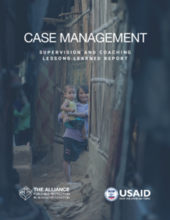Executive summary
Background
Over the past six years, the global child protection humanitarian community has invested significant efforts into setting standards and improving the quality of child protection case management in humanitarian settings. In 2017, the Case Management Task Force (CMTF) of the Alliance for Child Protection in Humanitarian Action (the Alliance) decided to prioritize the role of supervision, with coaching as a core approach and strategy. With OFDA’s support, the CMTF undertook the creation of Supervision and Coaching guidance, tools and a training package.
Purpose and methodology
The CMTF commissioned this project to gather and draft key lessons learned on the Case Management Supervision and Coaching initiative. Key questions that the Task Force wanted to address included feedback on the interagency country collaboration, the effectiveness of the localization approach, the successes and challenges of roll-outs in the eight participating countries, and the impact on case management teams’ supervision practices.
The information for this report was gathered through:
- A desk review of various sources;
- Stakeholder interviews;
- Online surveys of TOT participants; and
- Field visits to Iraq and Burundi.
Findings
The Coaching and Supervision initiative began with a desk review followed by pilots in three countries and a global, face-to-face consultation with experts from the CMTF to promote a common understanding of supervision and coaching and to set the framework of the initiative.
During the consultation with experts from the CM TF, countries were selected for the pilot phase based on criteria including foundations of case management within the national response and demonstrated commitment from the inter-agency community. Applicant countries had to submit a nominated team of participants from multiple agencies (UN, government, INGOs, and local NGOs).
Three TOTs were held, one each in Uganda, Jordan and Burundi. The selected country teams participated in an iterative, decentralized training of trainers (TOT) that included online precourse work and a Case Management Supervision and Coaching TOT. While there, the participants developed country-level roll-out plans.
Of the 60 TOT participants, 48 implemented trainings and verified them with written reports during the project period. The training modules and supervision tools covered four key areas:
- Defining supervision and coaching;
- Supervision and coaching practices and tools;
- Supervision and coaching skills; and
- Staff care and well-being.
Additional coaching and technical support that was provided by a remote or in-country support focal point (depending upon the context).
Overall, the initiative was effective in many areas. The majority of informants considered the process a true, coordinated, interagency collaboration from design through implementation (at global, regional, and country levels). The methodology of the TOT allowed participants to reflect on their own country’s context, hierarchy, relationships, and organizational structure and incorporate those into the country-level trainings.
On average, the country teams and trainers participating in the TOT saw an increase in post-test knowledge, confidence across harm prevention and supervision, capacity, and commitment. The training increased supervisors’ skills, knowledge, and capacity to coach caseworkers and improved their daily supervision practices. In Iraq and Burundi, the supervision practices also helped caseworkers better organize their work, improve their interactions with children and families, and feel more confident in consulting with supervisors to problem solve cases together.
While both supervisors and trainers felt the training was effective, participants did provide some suggestions for improvement. These included:
Providing follow-up through refreshers, regular exchanges and visits across agencies, and peer support groups.
Training caseworkers, particularly those supervising and coaching volunteers, on the supervision and coaching practices and tools so that they understand the approach and perceive these practices as coaching, not monitoring.
Including more representation from local organizations, field colleagues, and in-country practitioners in the global consultation to identify more effective focal points.
Providing additional support and mentoring for local roll-outs from the national and subnational team to increase the overall sustainability and harmonization of in-country efforts.
Recommendations
The report concludes with recommendations for supporting similar initiatives and the general sustainability of case management supervision and coaching in humanitarian settings. These recommendations target specific child protection/case management actors and fall into two general categories. The first is to engage in social service workforce strengthening and sustainability planning and implementation activities. These activities will help ensure the sustainability of supervision and coaching practices within in humanitarian responses and combat high turnover and limited funding that is a frequent challenge for case management actors.
The second is to apply the lessons learned and recommendations to future capacity-building initiatives. Such initiatives should feature an iterative, decentralized approach and methodology; a collaborative, interagency approach; local representation and contextualization; and widespread commitment within and between partner organizations.

